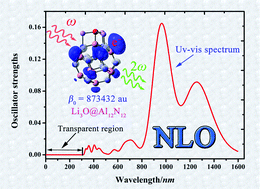A theoretical study on superalkali-doped nanocages: unique inorganic electrides with high stability, deep-ultraviolet transparency, and a considerable nonlinear optical response†
Abstract
By doping an Al12N12 nanocage with superalkali Li3O, a series of Li3O@Al12N12 compounds were theoretically designed and investigated for the first time. Computational results reveal that these species contain diffuse excess electrons, and thus can be regarded as inorganic electrides of a new type. As expected, these proposed electrides possess considerable first hyperpolarizabilities (β0) up to 1.86 × 107 au. In particular, the lowest-energy Li3O@Al12N12 exhibits high stability and excellent deep-ultraviolet transparency. Moreover, the effects of superalkali and nanocage subunits on the NLO responses of M3O@Al12N12 (M = Li, Na, K) and Li3O@X12Y12 (X = B, Al; Y = N, P) are systemically investigated. Results show that the respective substitution of Na3O and B12P12 for Li3O and Al12N12 can bring a larger β0 for such electrides. This study may be significant in terms of providing an effective strategy to design thermally stable inorganic electrides as potential high-performance NLO molecules.


 Please wait while we load your content...
Please wait while we load your content...